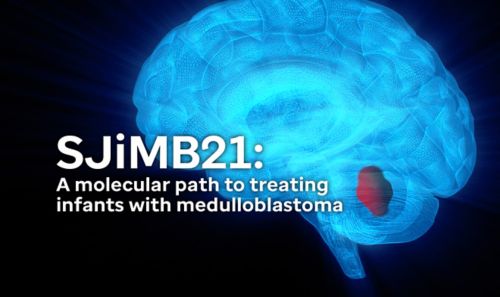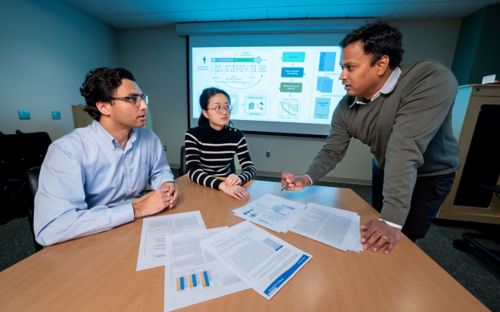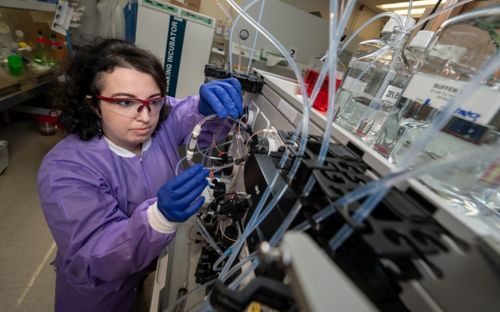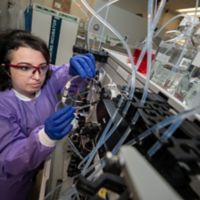SJiMB21: A molecular path to treating infants with medulloblastoma

Investigators at St. Jude are developing novel treatment strategies for infants and young children with medulloblastoma, the most common malignant pediatric brain tumor.
At St. Jude, clinical trial SJiMB21 seeks to provide treatment strategies for infants and young children diagnosed with medulloblastoma that place the patient, not just the tumor, at the center of care.
At St. Jude, an innovative clinical trial, SJiMB21, aims to identify what treatments best improve outcomes and quality of life for infants and young children newly diagnosed with medulloblastoma - the most common malignant pediatric brain tumor.
Medulloblastoma therapy - a brief history with Giles Robinson, MD
So medulloblastoma therapy has come a long way, but one of the main treatments of medulloblastoma therapy has been craniospinal radiation. And that means doing radiation to where the tumor was, but also doing radiation to the entire brain and the spinal cord. And that by itself had given kind of promising outcomes in the seventies and eighties. And it was that that got combined with chemotherapy that actually boosted up the survival rates close to what we are today.
The problem for what we call infants - so infants in brain tumors we describe as children who are under the age of three - trying to treat infants with medulloblastoma is trying to limit or do away with the craniospinal portion of irradiation. And the reason to do that is because the developing brain is very sensitive to radiation therapy. And so these children who are in the midst of development are very vulnerable to the radiation.
As a major challenge in the field, it's doing away with one of the best tools that we have.
Establishing a molecular understanding of medulloblastoma with Aditi Bagchi, MD, PhD
But what we learned was that some infants, some young children survived even without radiation. So the question is, who is surviving with radiation and who is surviving without radiation?
The molecular understanding of medulloblastoma has helped us understand that. What the molecular classification helps us do is differentiate the molecular low-risk disease from molecular intermediate disease to molecular high-risk disease.
And when we can identify those things even before treatment, that well, these molecular characteristics are associated with bad prognoses, then we can treat them accordingly. And that is the foundation of SJiMB21.
The patients who now we know require extremely aggressive therapy like radiation, we are giving them that therapy. We are also building strategies so that the long-term side effect can be mitigated.
Assessing neurocognition with Heather Conklin, PhD, and Jennifer Harman, PhD, IMH-E®
Evaluating cognitive and social outcomes with Heather
On SJiMB21, we will systematically evaluate both cognitive and social outcomes with a particular eye towards parent, family, and socioeconomic factors that may incur risk or foster resiliency. We're also going to evaluate a novel targeted intervention that pairs parent education with interactive neurodevelopmental games so that we can assess whether this is a feasible approach with these young children, as well as begin to estimate both cognitive and social benefits of this intervention,
Developing neurocognitive interventions with Jennifer
It is the first time that neurocognitive interventions are being done with the brain tumor population and studied in a treatment protocol here at St. Jude or elsewhere. And that's really so important because the first three years of a child's life really lays the foundation for their ongoing growth and development. And there's so much opportunity to make so much of an impact on their ongoing development during that time period.
Thinking broadly with Heather
We're thinking broadly about long-term effects, be that cognitive, social-emotional, but also things like endocrine issues, or having a secondary malignancy, or losing their hearing. And we know that children treated at a young age with some of the chemotherapy agents we use are at risk for ototoxicity or hearing loss.
Monitoring and preventing hearing loss with Johnnie Bass, AuD, PhD
Previous studies in children diagnosed with pediatric brain tumors has shown an independent association between hearing loss and neurocognitive deficits. Our goal in this study is to assess hearing loss throughout treatment as well as compare the neurocognitive performance.
I was approached to think about developing some hearing-specific aims for this protocol because it's so important, particularly for our infants, because they don't have speech and language necessarily at the time they're diagnosed with hearing loss.
So it's important for them to better understand how hearing loss impacts their development as well as fitting them with hearing aids as soon as possible so they don't lose any developmental milestones.
Pursuing a new path in medulloblastoma treatment
Joining therapeutic tenets with Giles
So one of the tenets of neuro-oncology at St. Jude is to improve the cure rates but also to decrease some of the toxicity of therapy. And I think the SJiMB trial kind of brings those two tenets together quite nicely because we're able to use this molecular risk strategy to give the patients the least amount of therapy that they possibly need.
Paving a molecular pathway with Aditi
So what I hope SJiMB21 will do is open a pathway. It will pave a pathway for other trials that is going to use the methylation profiling to molecularly risk classify other diseases.
Thinking long-term with Jennifer
So I think my ultimate hope is that we see more of these young children surviving and growing up and living long lives.
Expanding the big picture with Heather
My hope really is that we’ll show that this intervention is effective within SJiMB21, but also then be able to expand it so that we can improve quality of life for all young children undergoing cancer treatment.
Improving quality of life with Johnnie
So the quality of life was such a big part of this protocol. That was a big part of this protocol I felt like was how can we identify areas that we can help improve hearing outcomes in these infants and ultimately help improve their adult life.
Learn More
- Explore SJiMB21
- Learn more about the Department of Oncology at St. Jude
- Learn more about the Department of Psychology & Biobehavioral Sciences at St. Jude
- Learn more about the Audiology Services at St. Jude






